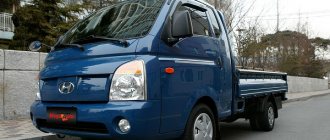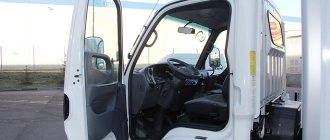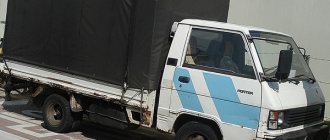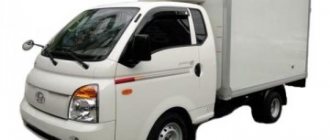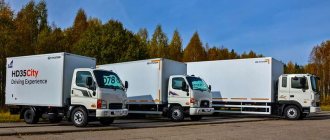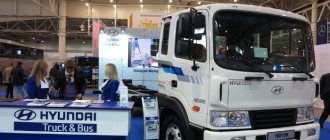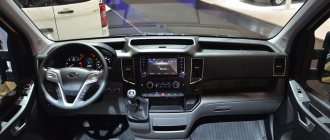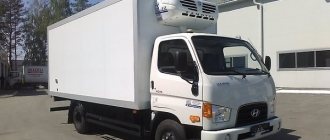KIA cars occupy a significant share of the Russian market. Among the cargo models of this Korean manufacturer, the new KIA Bongo III, which is available in various modifications, deserves special consideration. All trim levels are equipped with a variety of options, so buyers have the opportunity to purchase a car suitable for any purpose and operating conditions. The truck is equipped with a powerful diesel engine and all-wheel drive, which allows you to easily overcome difficult sections of the road. It is precisely because of this that this model should be very interesting for Russian consumers.
Truck Features
Bongo III was introduced to the Russian market in 2009. The main competitors are the domestic Gazelles and the Korean Hyundai Porter. The struggle between them is quite serious. After all, not all car enthusiasts can objectively assess the advantage of Korean cars, which are more expensive than Russian ones. It cannot be said that Bongo III wins this competition, remaining still an underrated car, because in terms of technical characteristics this model has a number of advantages over its competitors.
Thanks to the power steering, the driver may get the impression that he is driving a passenger car. Good maneuverability is ensured by smooth acceleration and an improved transmission that allows you to quickly change gears. The truck does not require special maintenance and is quite economical.
Bongo III is a versatile vehicle
One of the advantages of this model is its fairly affordable price. Maintenance is at a serious level. The car does not need frequent repairs, and the parts are inexpensive. Perhaps Russian consumers are a little wary of the versatility of the truck. After all, there is an opinion that a large number of functions leads to a loss of quality. But in this case this statement is wrong. Bongo III is a versatile vehicle that combines many features without compromising on quality.
Engine
Cars in this series are equipped with different types of engines, the most popular of which are the following: KIA D4CB turbodiesel and KIA J2 naturally aspirated diesel. The first option is more powerful - 133 horsepower. It complies with the Euro-5 environmental safety standard. Fuel consumption is 12.3 liters per 100 kilometers. Working volume – 2.5 liters. Speed – 3800 rpm.
The second engine option is more economical. Fuel consumption when using the KIA J2 engine is 9.9 liters per 100 kilometers. It is inferior to the more powerful version in terms of environmental safety (Euro-2). The working volume is 4.7 liters. Maximum power – 80 horsepower.
Thanks to the impressive torque (26 kg*m), the car easily starts from a standstill. There is enough traction for steep climbs. The car does not have outstanding speed characteristics, which is not surprising for cars of this class. The truck can stay in the middle of the road traffic without any problems - and that’s enough.
The engine complies with the Euro-5 environmental safety standard
What to choose – Kia Bongo III or Hyundai Porter II?
For a long time, light-duty trucks were in low demand in Moscow, since it was easier and more profitable to use vehicles with a larger carrying capacity. The situation changed in 2004, when a ban on the entry of heavy vehicles into the Third Ring Road came into force. Since then, the popularity of light-duty trucks has grown dramatically.
At first, the leader among such cars was the Hyundai Porter, but later it gave way to the Kia Bongo 3 and Hyundai Porter II. Both vehicles are reliable, easy to operate, excellent maneuverability and are excellent for cargo transportation in metropolitan traffic conditions. That is why a person who wants to purchase a vehicle for delivering goods in Moscow has a question: which of these two cars to choose? To make your decision easier, let's look at the features of each model.
Engine
Hyundai Porter II is equipped with a turbocharged four-cylinder diesel engine D4BF, power – 115, 126 and 133 hp. depending on modification. Advantages: Excellent traction. The carrying capacity according to the PTS is 995 kg, the real one is 1.5 tons.
Now about the disadvantages. Some models have an engine that meets the Euro-3 environmental standard. This is a serious disadvantage, since since September 1, 2016, there has been a ban on the entry of such cars into the Garden Ring. Violation is subject to a fine of 5,000 rubles or deprivation of rights for a period of 3 to 6 months. If you are interested in buying or renting a Porter, check which environmental standard the engine of the selected car meets. It must be no lower than Euro-4.
Kia Bongo 3 models are equipped with two types of engines:
- KIA J2. Power – 80 hp, consumption – 9.9 l/100 km, environmental class Euro-2. The car is only suitable for transportation in the region; cars with such an engine are prohibited from entering the Third Transport Ring.
- KIA D4CB. Less economical, but more powerful. Consumption – 12.3 l/100 km, power – 133 hp, meets the Euro-5 environmental standard.
The fuel consumption of the Kia Bongo 3 is lower: for the Hyundai Porter II it varies between 12.6-13.2 l/100 km.
Suspension
Both models have a dependent leaf spring rear suspension, and an independent torsion bar suspension at the front. But at the same time, cars behave differently on the road. The Kia Bongo 3 has better ride quality when driving on asphalt, but on uneven roads this car can sway a lot. The Hyundai Porter II suspension is stiffer, and the car behaves better on uneven surfaces.
However, the Kia Bongo 3 also has advantages: the suspension life of this model is higher.
The wheel arrangement of both cars is 4x4.
Comfort
Both cars are comfortable: a convenient dashboard, a high-quality driver's seat, beautiful design, and plenty of storage space. To understand which model is better, it's worth driving both - the decision will depend on your personal preferences.
In both cases, the package may include air conditioning, electric windows, and heated front seats.
Both cars are available in different versions - with a double and a triple cabin.
conclusions
Both cars are certainly good, so the decision to choose one over the other is best made based on personal preference. It is worth considering that, despite all the advantages of the Hyundai Porter II, this car is less common on the Russian automobile market than the Kia Bongo 3, and it may be more difficult to find a car with a suitable configuration.
Do you want to personally evaluate the advantages of each model? Rent Hyundai Porter II and Kia Bongo 3. We have both models in our fleet. Renting a car will help you figure out which car is best for you.
Technical characteristics of various modifications
The car has fairly good driving characteristics. Comfort of movement is achieved due to the soft suspension. A small turning radius (4.8 meters) provides good maneuverability, which makes the car very convenient for urban transportation.
Modifications of this model with all-wheel drive surprise with their cross-country ability. Cars overcome steep climbs and off-road conditions thanks to high ground clearance, short wheelbase and range. Additionally, you can install a rear differential - this will make cross-country ability even better.
The standard modification of the KIA Bongo III is a flatbed truck consisting of transverse beams connected to the body floor. The sides are made of steel. They are equipped with special equipment for securing cargo. To prevent damage to the cargo, rubber bumpers are installed. The technical parameters of this modification are as follows:
| Dimensions: | |
| Height | 1.9 m |
| Length | 4.9 m |
| Width | 1.7 m |
| Clearance | 14.5 cm |
| Rear track | 1.3 m |
| Front track | 1.5 m |
| Wheelbase | 2.5 m |
| Load capacity | 1.2 t |
| Turning radius | 4.8 m |
| Curb weight | 1.3 t |
| Engine: | |
| Working volume | 2.5 l |
| Model | D4BH |
| Type | Diesel with turbocharger |
| Number of cylinders | 4 |
| Torque | 23 kg*m |
| Fuel injection | Electronic |
| Cabin: | |
| Length | Standard |
| Width | Wide |
| Number of seats | 3 |
| Chassis and transmission: | |
| Rear suspension | Spring dependent |
| Front suspension | Torsion independent |
| Brake system | The front axle has a disc axle, the rear axle has a drum axle. |
| Parking brake | Mechanical |
| Transmission | 5-speed manual |
| Clutch | Single with hydraulic control |
The standard package includes:
- towing hook;
- fabric seat upholstery;
- tachometer;
- cabin heater;
- power steering;
- radio;
- clock in the salon.
The technical characteristics of the 4WD extended cab modification are as follows:
| Dimensions: | |
| Length | 5.2 m |
| Width | 1.7 m |
| Height | 2 m |
| Clearance | 20.5 cm |
| Front overhang | 1.2 m |
| Rear overhang | 1.3 m |
| Wheels | 4x4 |
| Rear track | 1.5 m |
| Front track | 1.5 m |
| Wheelbase | 2.6 m |
| Cabin: | |
| Length | Super |
| Width | Wide |
| Number of seats | 2+1 |
| Engine: | |
| Model | D4 |
| Working volume | 2.5 l |
| Number of cylinders | 4 |
| Power | 133 hp |
| Environmental Safety | Euro 5 |
| Type | Diesel with turbocharger |
| Fuel supply | Electronic |
| Chassis and transmission: | |
| Front suspension | Hydraulic torsion bar |
| Rear suspension | Spring |
| Clutch | Hydraulic |
| Transmission | Mechanical 6-speed |
| Brakes on the front axle | Disk |
| Brakes on the rear axle | Double-circuit drum |
The following additional options can be installed:
- air conditioner,
- heated mirrors,
- immobilizer,
- electric mirrors,
- central locking,
- fog lights.
The double cab version has the same basic parameters as the extended cab model. But there are also differences. The distinctive features of the 4WD double cab modification are as follows:
| Body dimensions: | |
| External volume of the platform | 2.6 cubic meters |
| Internal volume of the platform | 1.3 cubic meters |
| Length (external) | 2.3 m |
| Height (external) | 40 cm |
| Width (external) | 1.7 m |
| Length (inner) | 2.18 m |
| Height (internal) | 35 cm |
| Width (inside) | 1.6 m |
| Cabin: | |
| Length | Double |
| Width | Wide |
| Number of seats | 5+1 |
All about KIA Bongo
KIA Bongo III 4X4.
Compromise without compromise In addition to the ubiquitous Gazelle, several “civilized” brands are represented on the Russian light truck market. Among them are the Korean tandem Hyundai Porter and Kia Bongo. And if Porter has already gained some popularity among the people, then Bongo is still underestimated. Especially in the ultra-versatile all-wheel drive version.
The visibility and digitization of the instrument panel is flawless.
Some argue: universality is a vice. They say that the combination of several qualities in one product negatively affects the result. Perhaps, but, whatever one may say, our life is made easier in many ways by universal things. Of course, cars are among them. And to be more specific, the all-wheel drive Kia Bongo III is a striking representative of a successful compromise.
Born on the same assembly line as its blood brother Hyundai Porter, Kia Bongo is presented in a number of modifications in various versions. Along with a banal cargo platform, the manufacturer, for example, offers such an interesting “type” as a compact dump truck with unloading on three sides. Unlike its mono-wheel drive relatives, the twin wheels of the rear axle of which are significantly smaller in diameter than the front ones, the Bongo III 4x4 is equipped with the same single-pitch 15‑inch wheels. In the first option, using this arrangement, the goal is to reduce the loading height; in the second, the issue of increasing ground clearance is resolved. The Kia Bongo III is a functional vehicle. With a double cabin, like our hero’s, it’s doubly functional. It's too much to talk about the aesthetics of such cars. And yet it’s worth mentioning that, despite its modest appearance, the Korean truck is attractive at first... well, okay, at second glance. The friendliness of the car's appearance is emphasized by the smooth lines of the cabin, large block headlights, and a large windshield. A comparison with a tadpole involuntarily comes to mind. And who wouldn’t be touched by the sight of such a plump frog offspring!
The PTO "magic button" activates the power take-off shaft.
Inside, the Bongo III eloquently demonstrates the benefits of a cab-over-engine layout. It is essentially the interior of a minibus. Needless to say, in terms of spatial resources, no pickup trucks (unless, of course, we discard the atypical American mastodons) are even close to the Bongo. Here, where five people can easily be accommodated, and with a little difficulty all six people, you perfectly understand the true meaning of the term “double cab”. The degree of freedom of passengers is determined by the reserve of centimeters in all directions. And especially in height. For small luggage there is a glove compartment, mezzanines above the windshield, pockets in the doors and in the seat, and for larger things there are spacious compartments under the second row sofa. Practical plastic on the floor is adjacent to comfortable fabric seats and an impressive range of all kinds of amenities. Such, for example, as electric windows, air conditioning, audio system, heated driver's seat... Someone will say: “What a miracle!” Just don’t forget that we are not talking about an advanced passenger car, but about a commercial truck.
While in the cockpit, you involuntarily catch yourself thinking: where is the engine? Its location is declassified if you lift the right passenger seat. It remains to be seen how the creators of the car were able to fit a powerful 2.9-liter diesel engine into the unclaimed under-cabin space. Be that as it may, masters of camouflage worked on this issue. The question of ease of maintenance of the power unit is reasonable. Experts authoritatively say that getting to the oil dipstick is not a problem, and routine maintenance is the job of the service. Perhaps this point of view is somewhat biased, it is only based on the reliability of this engine, tested on other models of the Hyundai-Kia alliance. By the way, refilling coolant and windshield washer fluids is as easy as shelling pears - through an improvised hood in the front part of the cabin.
The power unit is hidden under the right front seat.
For serious luggage, our Bongo has a body two meters long and more than one and a half meters wide. You can transport a lot of stuff here, but perhaps a very significant point is the ability to transport almost all types of small equipment: snowmobiles, jet skis, ATVs, etc. The length of the body can be increased by 335 mm due to the tailgate being fixed in the folded position. And if you lower all three sides, you get a cargo platform for oversized cargo. And not only oversized, but also heavy, since the Bongo III 4x4 has a load capacity of under a ton.
It’s nice that the available one includes lining the underbody and the inner surfaces of the sides with aluminum panels, which reliably protect iron surfaces from scratches. And that means from corrosion. Among the trump cards of the car is also the ability to transport long items with the help of a durable support arch behind the cabin and folding clamps that act as side supports. It is possible to install a soft awning or a hard anti-vandal “cocoon” within the dimensions of the machine. And another nice little thing is the presence of a step located under the body in the center of the car, which greatly facilitates access to the cargo.
When lowered, the backrest of the center seat of the first row becomes a convenient table with cup holders.
From the driver's seat, it becomes clear that the car's designers worked on ergonomics. It turned out well. In any case, the instrument panel is clearly digitized and is in the field of view “without interference”, various buttons are within “manual” reach, and visibility is absolutely amazing. Not only do large windows create the effect of an aquarium, all-seeing mirrors complement the picture with exceptionally reliable information. And a special outside mirror on the right side allows you to park or maneuver with millimeter precision. The fact that you are driving an “off-road” Bongo III 4×4 can be judged by the transfer lever located next to the gearbox lever. A very interesting large button is located to the left of the steering wheel. It activates the power take-off shaft, the pulley of which is located in the center of the car, between the left wheels. With the help of this device, a mass of various external units can be driven by a simple belt drive. Let's say a water pump, a generator, a concrete mixer, etc.
Seats are reserved for two people next to the driver.
The engine of our Bongo has impressive torque already from one and a half thousand revolutions (and up to 3250 min-1), so the car starts easily and naturally. Moreover, it doesn’t matter whether the car is loaded or not, whether it starts from level ground or uphill - there is enough traction in any case. And for an emergency situation, say, heavy clay off-road, there is an “emergency reserve” in the form of a downshift. Bongo III's acceleration dynamics are average. Not a cannon, but not a turtle either. In any case, you don’t feel like an outcast in traffic. Moreover, the car allows you to easily stay in the center of the transport peloton, and without a load - sometimes lead the race. It is clear that this is not the most relevant characteristic of this vehicle, but sometimes efficiency is at the forefront. The good selectivity of the box allows you to “get” into gear without difficulty. Moreover, the clarity of the inclusions is not the only transmission virtue of the Bongo III. Thanks to a well-chosen gear ratio, the car moves without jerking or jerking, smoothly “swallowing” one acceleration stage after another. The car slows down less adequately. The dosage of braking force requires thought.
There are spacious storage compartments under the second-row sofa.
Full seats are provided for passengers in the second row.
Kia Bongo III has a characteristic feature due to its very soft suspension: while driving, the car is subject to significant vertical swing. Fans of attractions will squeal with delight, but as for ordinary citizens... People get used to everything. To be fair, it is worth noting that rocking is typical of an empty car. For a car crushed by a load, everything falls into place. In general, the suspension is amazingly energy-intensive. It is almost impossible to “break through” it, regardless of the condition of the road surface. The Bongo's ability to turn around literally on its feet also makes a strong impression. It’s a pleasure to maneuver in cramped conditions with such a ridiculous turning radius and taking into account the previously mentioned excellent visibility.
A driver's side step makes access to the body easier.
There is also no doubt about the off-road capabilities of the Bongo III 4x4. Connectable all-wheel drive, relatively short wheelbase, multiplier, impressive ground clearance (220 mm) - a good set for overcoming off-road conditions. But the car's potential doesn't stop there. Those who want to compete with a bulldozer in cross-country ability can order a self-locking (mechanical) rear differential instead of the standard one. The asking price is about $2000. Factory tuning. The reliability of the unit, according to reviews, is high. In general, this car is capable of kneading dirt admirably. This statement closes the chain of universal qualities of the Kia Bongo III 4x4. And the burning question arises about the cost of the car. And the price... is at least adequate, about a million. If we remember the cheaper UAZ “loaf” in a similar body configuration, then the quality and comfort of the UAZ, in comparison with the Kia, will not stand up to criticism. Well, if you think about the “habitat” of the Kia Bongo III 4x4, which covers many different spheres of human activity (geological exploration, agriculture, construction, farming, outdoor activities, hunting, and banal delivery of cargo to difficult climatic conditions, and much more), then the price begins to seem “delicious”.
note
- Curious. The PTO "magic button" activates the power take-off shaft.
- Comfortable. A driver's side step makes access to the body easier.
Igor Kuznetsov
Magazine "Autopark"
Useful:
- We hasten to inform you that the Suzuki Grand Vitara exclusive is the most popular crossover.
- https://auto-librare.com/ “Car Repair and Operation Manuals” can help you keep your car in good technical condition.

